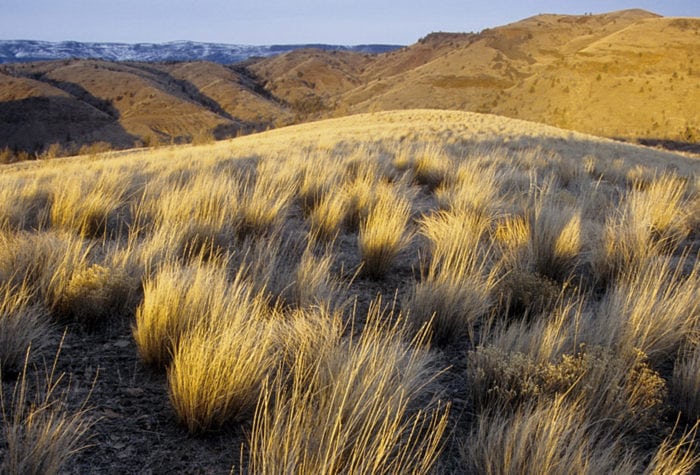Summit Creek Planting #2
Sage Brown Website
| Organizer: Sarah Lindsay
Start Date: Thursday, October 17, 2024 End Date: Sunday, October 20, 2024 Region: Malheur River Basin Difficulty Rating: Level 3: Challenging Maximum Group Size: 15 participants |
About the place
ONDA’s conservation work takes place on the traditional lands of the Northern Paiute, Wasco, Warm Springs, Bannock and Shoshone people, as well as ceded lands of the Confederated Tribes of the Umatilla Indian Reservation, and on lands currently managed by the Burns Paiute Tribe and the Confederated Tribes of Warm Springs. Many Indigenous peoples live in Oregon’s high desert region today, including members of the Burns Paiute Tribe, the Confederated Tribes of Warm Springs (Wasco, Warm Springs and Paiute), the Klamath Tribes (Klamath, Modoc and Yahooskin) and the Fort McDermitt Paiute and Shoshone Tribe.
Summit Creek is a tributary of the Malheur River that provides critical habitat for bull trout, redband trout, and other native fish and wildlife species. The Prairie City Ranger District of the Malheur National Forest has implemented a large scale restoration project along the creek. This planting will contribute to the overall restoration of the area by enhancing native vegetation along the creek to provide shade and cool water for native fish, improving ground water storage capacity and increasing wildlife habitat. ONDA volunteers will be planting willow, dogwood, and other native plant species.
Since 2014, ONDA has helped the forest to implement a variety of ambitious, multi-year projects restoring key fish habitat on headwater streams, including past work along Summit Creek.
About the stewardship work
Volunteers will work with ONDA and Malheur National Forest staff to conduct two days of riparian planting along Summit Creek, planting a variety of riparian species. The planting work will involve pounding metal spike into the soil to create a hole, then sticking willow cuttings, or stakes, into the hole. These stakes will then sprout roots and grow into a lush riparian forest that will shade the stream, resulting in cooler and cleaner water for fish and wildlife as the plants mature.
We typically head to the work site at 8 a.m. and stop work by 4 p.m. in order to leave time in the afternoon to clean-up, relax, and cook a well-deserved dinner. No previous planting experience is needed to attend this trip. ONDA and Forest Service staff will provide all instruction and necessary tools to do the job. All that is required is a love of the high desert, a big smile and a willingness to learn.
Trip timeline
- Thursday, Oct. 17, 5-7 p.m.: Volunteers should plan to arrive in the evening with enough time to set up, meet others at camp, and spend some time talking about the weekend ahead.
- Friday, Oct. 18: Our first of two work days. We will meet with Forest Service staff and carpool to the work site. After a brief safety talk and a discussion of the restoration efforts, we will begin planting. Plan to be away from camp from about 8 a.m. to 4 p.m.
- Saturday, Oct. 19: Our second day of work planting along Summit Creek. Plan to be away from camp from 8 a.m. to 4 p.m.
- Sunday, Oct. 20, 8 a.m.: After a good night’s rest, volunteers can pack up and head home or take their time exploring the area before hitting the road.
Camp
We will be car camping at Big Creek Campground which has potable water and vault toilets and is a short drive from the work site. ONDA will bring extra group camping supplies such as tables, chairs, and extra water. Further details describing camp and driving directions will be provided to participants in the trip details email three weeks before the trip.
Difficulty
Participants will be bending down, carrying boxes of plants, digging holes and navigating uneven terrain. Everyone can find a task that works best for them and work at a comfortable pace with frequent breaks.
Participant responsibilities
Participants are responsible for their own food, water and, camping gear as well as transportation to and from the trip. The trip leader will facilitate carpooling amongst participants. Sturdy ankle-high boots are required for this trip. Volunteers should be prepared to be away from camp all day each of the work days. A more complete packing list will be sent to participants by the trip leader three weeks before the trip.
Gear provided
ONDA will provide tools for the work, work gloves, and eye protection. We will bring some group camping equipment (tables and chairs), extra snacks and drinks, and expert leadership.
Registration
An ONDA registration application and medical form are required for this trip.
Registration Opens July 16
What happens next?
You will receive a confirmation email within 2 weeks of submitting your form. The confirmation email will provide information regarding which trips you are on the “participant list” for, and which trips are full, and therefore you have been placed on the “waitlist.”
Six weeks before the start of the trip, the trip leader will send out an RSVP to make sure everyone is still able to participate. Based on RSVPs, open spaces will be backfilled with people from the waitlist.
Three weeks before the trip start date, registered and confirmed participants will receive driving instructions, maps, car-pooling options, and additional information in an email sent by the trip leader
If you have any questions in the meantime, please don’t hesitate to contact the trip leader.
This trip will be led by Sarah Lindsay. If you have questions, you can contact her at slindsay@onda.org.
Meet SarahONDA's Restoration and Stewardship Work
Over the last two decades, ONDA has engaged volunteers in projects to plant thousands of trees, restore dozens of miles of streams, decommission old roads, and remove enough barbed wire […]
Read More